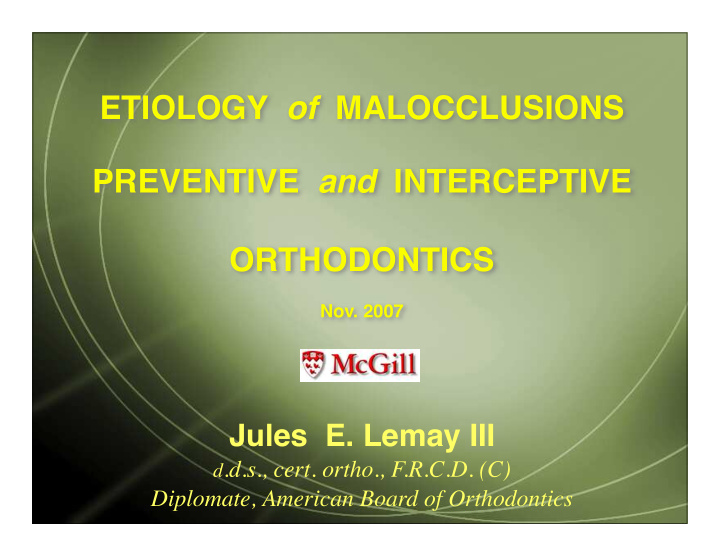



ETIOLOGY of MALOCCLUSIONS PREVENTIVE and INTERCEPTIVE ORTHODONTICS Nov. 2007 Jules E. Lemay III d .d.s., cert. ortho., F.R.C.D. (C) Diplomate, American Board of Orthodontics
EPIDEMIOLOGY OF MALOCCLUSIONS ✦ USA (various studies): � 35 - 95% ✦ USPHS (1960’s): ● most thorough epid. study ever done ● statistically representing 26M (6-17y) ● Grainger’s TPI (severity) � � 75% Occlusal Disharmony 25% Near-ideal Occlusion 2
ANGLE CALSSIFICATION (Molar Relationship) ✦ NORMAL � 25% ✦ CL-I � 50-55% ✦ CL-II � 15-20% ✦ CL-III � 1% � � USPHS 1960’s, age 6-17 3
Why early orthodontic screening? 6’s erupted = Post. Occl. established AAO Detection of: Recommendations ✦ Fct. habits, crowding, deep/open bites 1998 ✦ AP & transverse discrepancies Benefits: « influence» jaw growth , harmonize width of arches ✦ ✦ improve eruption patterns, ✦ lower risk of trauma to protruding U inc. ✦ correct harmful O. habits ✦ improve esthetics & self-esteem ✦ simplify / shorten Tx time for later corrective phase ✦ reduce likelyhood of impactions ✦ improve some speech problems ✦ preserve / gain space for erupting perm. teeth 4
INCIDENCE OF PROBLEMS ✦ CROWDING � 40% (age 6-11) � � 85% (age 12-17) ✦ OVERJET (> 6mm) � 16% (CL-II & skeletal) ✦ CL-III MOLARS � 1% ✦ ANT. OPB (> 2mm) � 1% whites � 10% blacks ✦ DEEP BITE � 10% whites � 1% blacks ✦ POST XB (>2 teeth) � 6% USPHS 1960’s / age 6-17 5
ETIOLOGIC FACTORS Classification ✦ Inherited & Acquired ✦ Predisposing (direct) & Determining (indirect) � (Mc Coy 1956) ✦ 7 Causes & Clinical Entities (Moyers, 1958) ● Heredity ● Developmental defects of unknown origin ● Trauma (pre & post-natal) ● Physical agents (pre & post-natal) ● Habits (thumb , fingers, tongue, etc...) ● Diseases (systemic, endocrine) ● Malnutrition ✦ Extrinsic (general) & Intrinsic (local) 6
ETIOLOGY OF MALOCCLUSIONS E Y N T V I I R D malocclusions O E N M R E E N T H ..7..
TERMINOLOGY ✦ SERIAL EXTRACTIONS (Kjellgren, 1929) ✦ GUIDANCE OF ERUPTION (Hotz, 1970) ✦ GUIDANCE OF OCCLUSION ...influence tooth eruption into a favorable occlusion... 8.
COMPLETION OF ANTERO-POST. MANDIBULAR GROWTH AGE 9 � 85% � 90% � 13 � 90% � 95% 15 � � � � � � � 98% 19 � � � 98% � Wolford et Al., O. Surg., 1973 - 45:3 9.
SERIAL EXTR. - CASE SELECTION (ideal conditions) ✦ NO SKELETAL DISHARMONY (Good facial balance / harmony) ✦ CL-I MOLAR RELATIONSHIP ✦ MINIMAL OVERBITE & OVERJET ✦ SEVERE SPACE DEFICIENCY � � ( > 10mm / ARCH) 10.
TYPICAL SERIAL EXTR. SEQUENCE 1- PRIM. CUSPIDS (C’s) - relieves inc. crowding � � 2- PRIM. 1st MOLARS � (D’s) - accelerates 4’s eruption � � 3- 1st PREMOLARS (4’s) � � -provides room for 3’s eruption 4- MECHANOTHERAPY 11
ROOT FORMATION vs ERUPTION (Longitudinal Studies, Moorrees et Al., 1963) ● ROOT 1/2 � STANDS STILL ● ROOT 3/4 � EMERGES into O.C . � � � ROOT 1/4 1/2 � ROOT 1/2 3/4 2. 5 years � � + � � 1.5 years � = 4y 3’s 4’s 1.75 years � � + � � 1.5 years � = 3.25 y 1/4 1/2 SG 15.2 3/4 ..12..
ALTERNATE S. EXTR. SEQUENCE 1- D’s (keep the cuspids) ● Avoids Li tipping of incisors ● Prevents bite deepening ● Accelerates eruptionn of 4’s 2- 4’s & REMAINING PRIM. CUSPIDS ● makes room for 3’s 3- MECHANOTHERAPY (fixed appliances) 13
Serial Extractions - Alternate Sequence Indications : -Dentoalveolar protrusion -Minimal incisor crowding -3’s & 4’s at same level x -Extr. D’s to accelerate 4’s x -Keep the C’s 14.
SERIAL EXTRACTIONS CONCLUSIONS ✦ No cookbook approaches... ✦ Not a licence for no supervision ✦ Take pan-Xr, evaluate space ✦ Have specific Tx objectives ● Explain them to parents & patient (Phase-II & mechanotherapy usually indicated) ● Short & Long term goals ● Esp. when extracting permanent teeth ✦ When in doubt, DON'T take them out… 15
CONGENITALLY MISSING TEETH (% POPULATION) U & L 8’s � 20-30% U 2’s � 1.5% L 5’s � 1% U 5’s � 0.5% L 1+2+3+4’s � 0.5% AAO ORTHODONTIC DIALOGUE - Summer 1989: 4 16
Recommend
More recommend